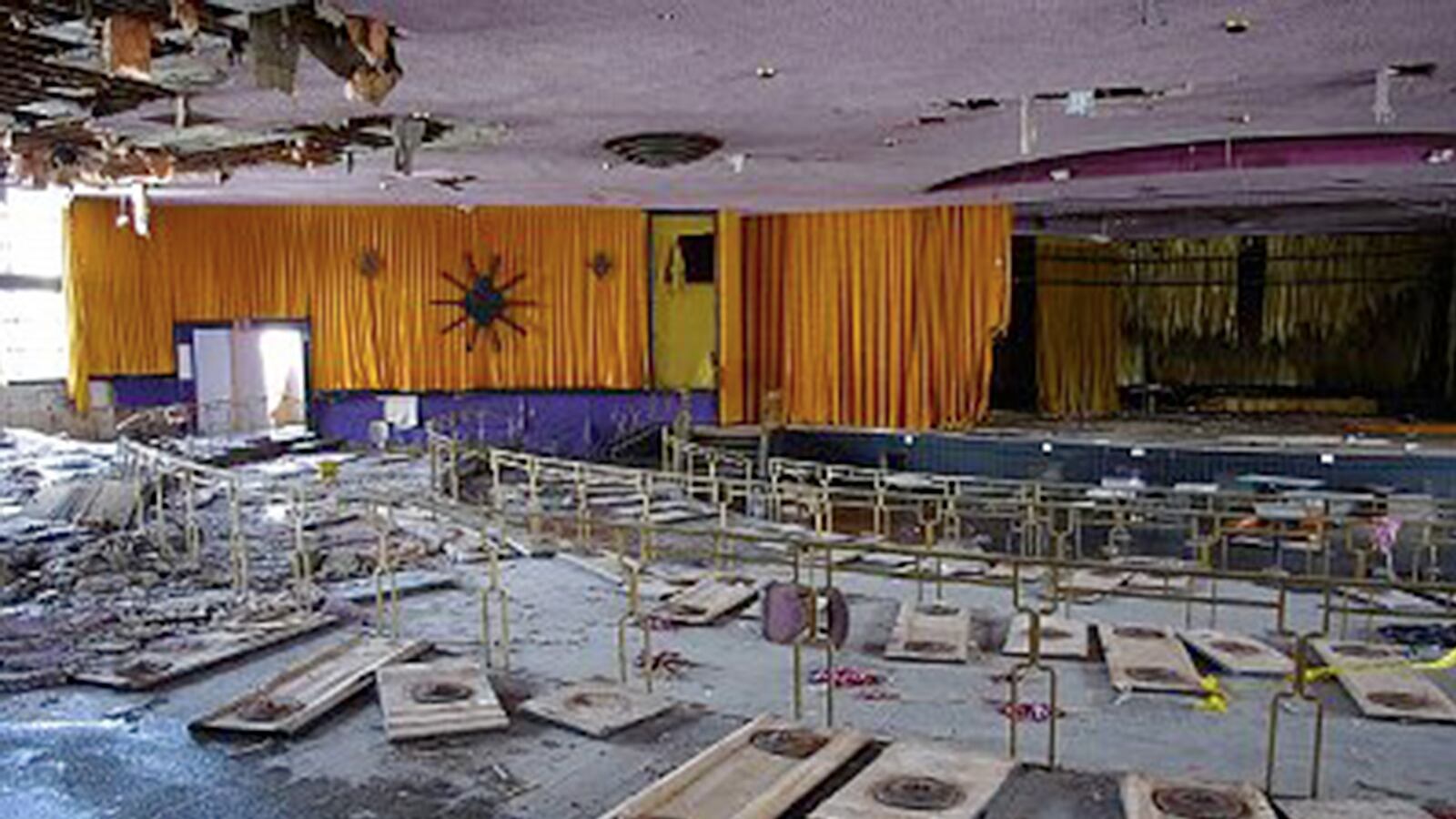Phones on desks, linens on beds, catalog cards spilling out of the filing cabinets—all covered with a fine patina of dust. Neglected for years, and abandoned in seconds, it’s like a modern-day Pompeii in which the earth suddenly reclaimed its souls as they went about their daily business.
But this isn’t fodder for the next Dean Koontz thriller; it’s real, and it's 100 miles north of New York City. Sullivan County once boasted 538 hotels and over 50,000 bungalows, but today practically nothing remains of this illustrious, vacationing era, save crumbling towers and abandoned estates.
Walking through the haunting wreckage—thirsty swimming pools filled with garbage, and rows of hotel towers tagged by vandals—it’s almost impossible to believe that area was one of the most important vacation destinations in America for well over a century.
John Conway, the official Sullivan County historian, adjunct professor at SUNY Sullivan—and author of six books including Remembering the Sullivan County Catskills—dates the start of tourism in the Catskills to well before the Civil War, when tales of mammoth trout lured sport fishermen up to the region.
The advent of the railroad brought droves of vacationers at the end of the 19th century during what Conway refers to as the Silver Era, and for a while Sullivan County was an important destination where tuberculosis patients could convalesce.

In 1914, Selig Grossinger, a Jewish immigrant living in New York, moved his family to the Catskills in an attempt to cure his health issues caused by urban life. He bought a farm for $750, and quickly realized there was more money in renting rooms to summer boarders than there was in tilling the land.
After a fruitful year (earning $81 total) he expanded his enterprise. But Grossinger wasn’t alone, Conway notes. “By the 1920s the rise of big hotels took the Catskills by storm, almost all of which were exclusively Jewish.”
The sliver of Sullivan County that the newspapers dubbed the “Borscht Belt” was a haven for Jewish immigrants who were turned away from other holiday destinations.
In the Catskills they could eat kosher food, spend time with their extended families, and engage in the very American practice of vacationing, a pastime that didn’t exist in the Old Country.
As the popularity of these Jewish resorts continued to grow, many of the estates expanded to epic proportions, eschewing the appeal of the surrounding nature in favor of becoming a beached version of the modern-day cruise ship, offering everything anyone would need under one roof.
Thousand-person theaters sprung up, and the casts of resident entertainers, which included the likes of Milton Berle (né Mendel Berlinger), Sid Caesar (né Isaac Ziser), and Alan King (né Irwin Kniberg), were largely credited with birthing American comedy as we know it today.
These summer havens were the training grounds for future television and film stars, and, as Conway explains, “It was the Saturday Night Live of its time, spawning the great entertainers of the ’30s, ’40s and ’50s—it was the Catskills’ Golden Era.” Even after the proliferation of TV, the major resorts would lure big-ticket names like Joan Rivers and Rodney Dangerfield for a night of laughs.
Sports, too, were an important part of the kingdoms of the Catskills. Basketball matches were orchestrated for entertainment purposes, and entire NCAA teams would take up residence at the different estates to hone their craft during the extended interim between semesters. “Wilt Chamberlain quite famously spent some time in the mountains, working as a bellboy during the day and playing ball on the resort’s team in the evenings,” says Conway.
Sullivan County’s summertime influence on American sports and entertainment become such an important fixture in society that several films were created about the era, most notably Dirty Dancing, the wildly popular 1980s movie starring Jennifer Grey as the daughter of a wealthy Jewish family, and Patrick Swayze as a working-class dance instructor. The action takes place at the fictitious Kellerman’s, an idyllic world of holiday bliss, which, according to Conway, was “inspired by the real-life Catskills resorts like Grossinger’s.”

The hotels were, for a couple of decades, truly magnificent, but Conway insists, “It was all built upon smoke and mirrors.” Behind the resorts’ veneer, unbeknownst to its guests, was a vicious game of one-upmanship that escalated with each passing summer.
“Each year the largest properties would unveil their latest gadget or gimmick to lure patrons back for the following season,” says Conway, the best example of which was the advent of the indoor pool. In 1958 Grossinger’s revealed a mammoth natatorium bedecked in a generous surplus of art deco detailing. Constructed at a huge cost, it forced the neighboring properties to take on a similar financial burden, and four years later there were over 30 indoor swimming pools in the region.
“Unable to recoup the insurmountable costs, the hotels struck lending deals with local vendors and banks,” says Conway, but the act of keeping up with the Joneses ultimately proved unsustainable, even for the hegemonies like Grossinger’s, and by the late ’60s most resorts had reached the point of no return.
Although the end was truly nigh by the end of the decade, rabid overspending wasn’t the sole conspirator in the demise of the Catskills' golden era. Conway refers to the other important factors as the “three ‘A’s”: air conditioning, assimilation, and airfare.
Sullivan County had long garnered a reputation as a place of wellness, often being quite literally what the doctor ordered for those unable to properly convalesce in the city, but the advent of air conditioning made it less of a necessity—especially for vacationers with smaller budgets—to escape the Big Smoke for breezier weather.
Dr. Phil Brown, a sociology professor at Northeastern University, founder of the Catskills Institute, and author of Catskill Culture: A Mountain Rat’s Memories of the Great Jewish Resort Area, cites the gradual melting away of anti-Semitism in America as “the primary reason for the decrease in the region’s Jewish clientele.”
As prejudices waned, it became easier and ultimately desirable for Jews to fully assimilate. Once other holidaying destinations around the country lifted their ban on Jewish patrons there was less of a need to coalesce in the Catskills, and as Brown says, “it became easier for young Jewish professionals to find jobs in the city,” meaning that they no longer needed to subsist on summer resort wages to fund their education.
But on a greater scale, the assimilation slowly chipped away at the tight family bonds formed long ago in the shtetls of Eastern Europe; a great number of American Jews intermarried with other faiths, and divorce became more commonplace in general. The younger generation, keen on being defined as American first before any other trait, saw little need to participate in Jewish activities as well.
“The broader acceptance of the nation’s Jewish population also led to a massive migration of Jews within America,” notes Brown. They left New York City for Los Angeles and Miami with the same spirit that led the previous generation over from the Old Country, as documented in Debra Dash Moore’s book, To The Golden Cities.
By 1970, Los Angeles held the world’s third-largest Jewish population after Tel Aviv and New York City, and few newly minted Californians saw the need for a forested holiday retreat when they were now living year-round in what Brown dubs “vacationland.”
For Brown, an increase in affordable airfare further encouraged American Jews to travel within the U.S. and beyond: “Jews were comfortable returning to Europe for holidays by the 1960s.” Brown believes that the all-inclusive structures of the Catskills hotels were the inspiration for the resort schemes in the Caribbean.
Suddenly, like a slap in the face, it seemed as though the Catskills were completely out of fashion. “It was so opulent that no one ever thought it would sink, then boom—it was gone,” says Conway. Although the majority of the 500-plus hotels have been rendered to ash, there are still a few places like Grossinger’s—a veritable college campus in size and scope—that stand silent amongst the encroaching weeds.
For some, the wreckage has become a tourist attraction in its own right, like traipsing through the Ukranian city of Pripyat, abandoned after the Chernobyl disaster. Multi-story hotel towers stand stripped of any ornamentation, and seem almost Soviet in their austere and honest decay. Tattered curtains flutter out the cracked windows, roofs collapse under the cruelty of weather and time, and empty hallways echo with the footsteps of curious trespassers.
At Kutsher’s, one of the last great resorts to bite the dust, a security officer stands guard, warning onlookers of the threat of asbestos within. Tractors have parked in front of the ruins; the estate was recently purchased by an Indian lifestyle brand with intensions to sink over $90 million into the development of a yoga retreat. If all goes according to plan, it will be the first step in bolstering the reputation of a county that has its sights set on much more than wellness: The latest aim is to transform the area into a $500 million casino resort.
Conway is optimistic about the recent renewal in interest in the region’s potential as a center for holidaymakers, but—big, shiny gambling megaliths or not—he’s certain that the golden era of hundreds of his so-called “fortress hotels” is gone forever.





